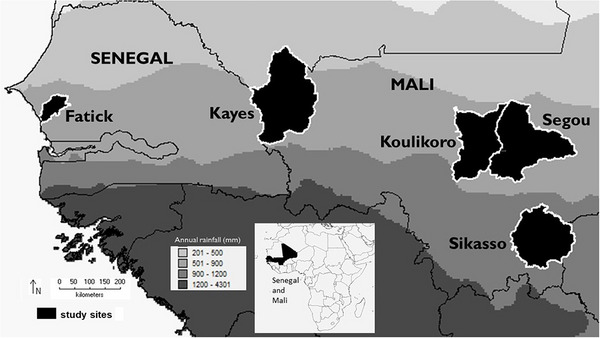Food systems around the world are facing three main challenges: 1. ensuring food and nutrition security for a growing population under climate change, 2. providing livelihoods for farmers and other stakeholders in the value chain and 3. improving environmental sustainability. Ecological intensification aims to address all three challenges by increasing yields, reducing reliance on agrochemicals, promoting agro-biodiversity, and building food system stability. Scientific advances, international organizations and governments identify agroforestry as an important leverage for adaption towards climate-smart agriculture. As the Sahel region is especially vulnerable to droughts and other shocks such as conflict, meaning that combating malnutrition and rural poverty is exceptionally challenging. Furthermore, climate change is, and will continue, to affect the region disproportionally.
Under these circumstances, the integration of shrubs and trees into cropping systems has a small but valuable role to play. The positive impacts of agroforestry are associated with the hydraulic redistribution of water among the trees or shrubs and annual crops, the availability of tree and shrub biomass to improve soil health, and a diversification of nutrition and income sources. Positive livelihood impacts of farmer-managed regeneration of existing tree crops have been documented in Niger and evidence from Senegal suggests that the integration of trees and crops has great potential to positively affect ecosystem services, such as temperature and moisture levels, which can ultimately increase yields. Diffusion and adoption of innovative techniques is a complex socio-economic process influenced by many factors and little is known about these drivers in relation to agroforestry. Therefore, the study by Grovermann et al. aims to understand this process better by examining which agricultural practices are jointly adopted with agroforestry and by assessing the determinants of agroforestry awareness, adoption intensity and desorption decisions.
How to investigate adoption?
The research focused on five regions - namely Fatick in Senegal and Kayes, Koulikoro, Segou and Sikasso in Mali - engaging with almost 3,000 farm households. Within these regions ~80 villages were selected randomly and within each village 6-9 households were randomly selected to participate in the survey. The households operated either by cropping or integrated crop-tree-shrub systems, and lay in the semi-arid zone of the Sahel. A structured questionnaire, consisting of ~250 questions covering plot, household, and village-level characteristics, was designed, pre-tested and then used for field surveys in 2019 (Mali) and in 2020 (Senegal).
Main insights into agroforestry adoption
The analysis revealed that receiving information on sustainable agricultural practices from community exchange was consistently seen to have positive associations with the use decision of all agroecological practices for both countries. Information from government or NGO extension services was also consistently associated with a greater likelihood of practice adoption. Moreover, having received sustainable practice information from community exchange was associated with a significantly reduced likelihood of disadoption of agroforestry.
Overall, the findings suggest that extension access and training participation boost awareness of agroforestry-based soil fertility management, while information provided by public extension, NGOs and community members is strongly associated with adoption of agroforestry techniques. Moreover, farmer-to-farmer exchange in the community was a key factor in the decision to maintain agroforestry. Membership in cooperatives and youth groups appeared to have a favourable effect on awareness and adoption in Mali, but less so in the Senegalese case. Similarly, only results from Mali show that adoption of agroforestry is accompanied by the adoption of other sustainable intensification practices (such as mulch composting, intercropping, improved rotation, manure application and improved varieties) and lower use of synthetic pesticides.
The study illustrated how extension access, together with participation in training, enhance awareness of agroforestry in the case of Fatick. Information on sustainable agricultural practices provided by public extension services and private NGOs, alongside community information flows and membership in social networks, are key drivers of the extent of agroforestry use. For disadoption, information exchange on sustainable agricultural practices in the community appears an important lever to encourage continued use of the practice. Youth and cooperative membership appear to have a favorable relationship with agroforestry use, albeit not significant for Fatick, Senegal. In terms of joint decisions, the study concludes that agroforestry uptake is generally complementary to the use of other practices, with some indications of substitution, in that farmers who use synthetic pesticides are less likely to make use of agroforestry and vice versa.
What lies ahead?
Strengthening the capacity of public and NGO-based advisory systems appears an essential step in premoting greater uptake of agroforestry. Importantly, these organisations need to fully engage with local knowledge networks. Improved information flows on sustainable agriculture from these sources are key to supporting the transition to more widespread agroforestry-based soil fertility management. Furthermore, solutions for agroforestry microfinance are needed to back up knowledge gains with the financial means for implementation. Instead of disseminating stand-alone solutions, a package of agroforestry, mulching, rotations, use of manure, improved varieties and intercropping can be jointly promoted.
Research paper written by: Christian Grovermann (FiBL - Research Institute of Organic Agriculture), Charles Rees (FiBL), Assane Beye (Université Cheikh Anta Diop–UCAD, Dakar, Senegal), Tesfamicheal Wossen (International Institute of Tropical Agriculture–IITA, Bamako, Mali), Tahirou Abdoulaye (International Institute of Tropical Agriculture–IITA, Bamako, Mali), Harun Cicek (FiBL)
Summary written by: Madelaine Rüger (FiBL)
Further information
Weblinks
Full paper for more nuanced insights and methodological reflections

 tap and then scroll down to the Add to Home Screen command.
tap and then scroll down to the Add to Home Screen command.